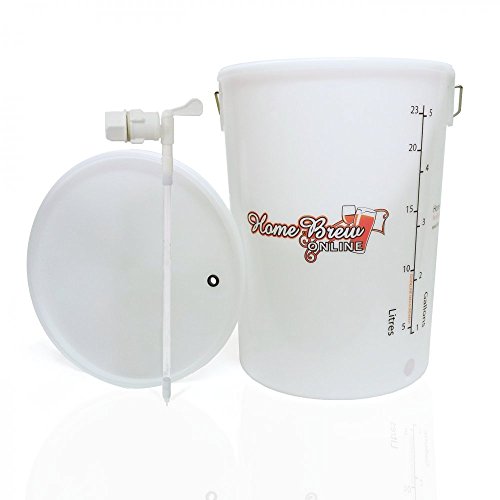Fermenting Bucket vs. Demijohn / Carboy
Although I think this is primarily an issue of personal preference (and bears no noticeable effect on the outcome of your beer) I am going to look at the choice of fermenter or fermenting vessel the home brewer uses.
I have seen a lot of posts that discuss this topic and a couple of things keep cropping up; should your fermenter be plastic or glass and to a certain extent should you use a fermenting bin or a demijohn/carboy. Keep in mind though if you make sure the fermentation environment is right the choice of fermenter shouldn’t make much difference.
What’s The Difference Between a Demijohn and a Carboy?
Let’s start off by clearing up this first point. There is no difference between a demijohn and a carboy. Demijohns or carboys a basically big bottles that can be sealed with a bung. They can be made out of either glass or plastic and usually between somewhere between 1 gallon and 5 gallons in capacity. They are most commonly referred to as demijohns in the UK and carboys in US, Canada and Australia I believe.
Other than the naming they are exactly the same thing so if I refer to it as one way or the other, hopefully you’ll know what I mean.
Which Fermenter and When to Use It
First of all I’m going to say that I use no glass at all for making beer. People seem to think that glass is superior to plastic for all sorts of reasons, some reasons being better than others. Let’s take a look at some of the advantages of using glass demijohns over plastic:
- Glass doesn’t scratch and is easier to clean (scratches in plastic can harbour bacteria)
- They last longer than plastic fermenters (in most cases)
- They are non-porous so there is no chance of oxygen getting to your beer (over long periods)
I think cleaning is the key thing here in my opinion, if you use a plastic carboy (better bottle) to do your fermentation, they are going to get scratched if you clean them with any sort of abrasive pad. If you use a better bottle as your primary fermenter then the krausen that gets gummed up all the sides is going to be difficult to scrub off compared to using a glass demijohn where you can use a bottle brush.
Personally I use a plastic fermenting bin for my primary fermentation. The obvious advantage to over using a demijohn is fermenting bins don’t have a narrow neck so you can easily wipe off all the debris with a damp cloth. Once primary is over I rack the beer into a plastic demijohn for secondary or just leave it in the bucket until I’m ready to keg. This means there isn’t a lot of crud to clean off so there are no real disadvantages to using plastic here.
The Best Fermenter to Use?
Any fermenter you choose is going to have advantages or disadvantages but as long as you are comfortable using it then don’t worry about it.
I think for the vast majority of brewers in the UK the most popular choice of fermenter is a bin/bucket because they are easy to move, store (because they stack inside each other) and are much cheaper than any other option on the market. If you are worried about scratches and discolouration then you can buy 2 fermenting bins here in the UK compared to 1 “Better Bottle” demijohn let alone a 5 gallon glass demijohn.

Another advantage with using a fermenting bin is you can easily fit a tap which makes racking and moving the beer a breeze compared to a demijohn. Lastly I have seen a lot of pictures recently of pools of beer on the floor with shattered glass floating around, in a couple of cases even reports of serious injuries. This is primarily caused in my view because glass fermenters are heavy and whilst glass is robust plastic in comparison won’t dangerously shatter and crack under stress or temperature changes.
I do use glass demijohns but only really for winemaking. In the UK the most common size of demijohn/carboy is 1 gallon which is just impractical for beer. Larger demijohns as I said before are just too expensive in comparison to plastic. In the end though, even if you have read this entire post I really don’t think it matters, point me to anyone that can tell me what sort of fermenter a beer was made in, whether it be a bucket or a demijohn and I’ll eat my hat!





I am looking for a 20 liter demi-john carboy…but can’t seem to find a 20 liter one.
Hi, I believe 20 litres is equal to 5.2 US gallons so this – http://amzn.to/2AdPGfg is just under 20 litres. A 6 gallon carboy like this – http://amzn.to/2hAa7Lo would be equal to 22 litres so these are probably the closest options for you.
Thanks I found your review very helpful, I have just started making wine from kits.
Advantages of 5 clear glass demijohns vs. one plastic brewbin… 1. if you get a problem (bacteria etc) you don’t lose the full batch. 2. You can see what is happening through the glass. 3. You can lift up easily and swill around to oxygenate and mix. 4. You have more flexibility in storage – narrow shelves, around other things etc. 5. You can experiment more with different mixes or ingredients .. Disadvantages? More time and faff in filling, airlocking, racking and cleaning, but not that much more.